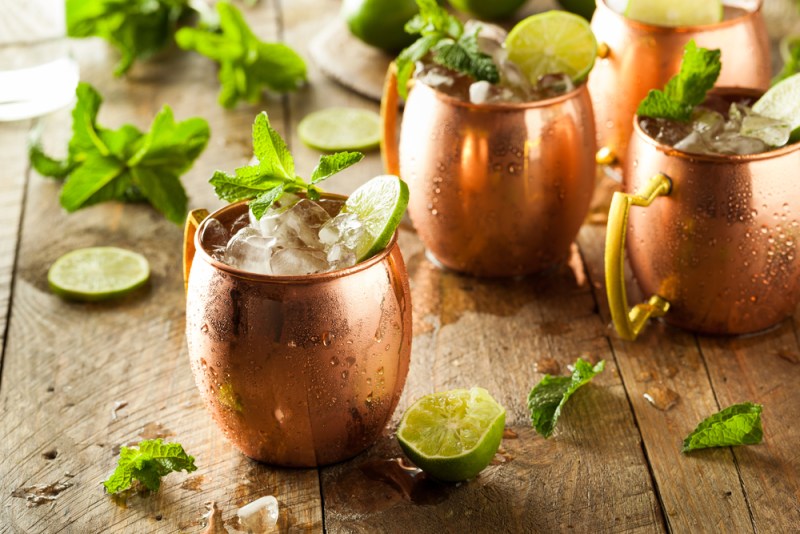When you think of ginger ale you probably think of a pretty watered down soda used to soothe a stomachache or mix with drinks. But, what comes to mind when you think of ginger beer? Is it actually a beer? Is it gluten-free? What cocktails is it used for? We’ve broken down the basics, and added some refreshing recipes for you to try!
The Key Differences
The differences between the two have been widely discussed and while they share plenty of similarities, there are a few things that differentiate the two:
- Ginger beer is fermented while ginger ale is carbonated water flavored with ginger.
- Ginger ale is non-alcoholic while some ginger beers still offer an alcohol content of 0.5%
- Some ginger beer will have a stronger taste than ginger ale given that some companies tweak the ginger levels to be significantly higher.
- It can also appear a bit cloudy whereas ginger ale comes out with a clear yellow color.

Shuttertock/Ben Gingell
Ginger Beer: Is It Alcoholic?
Traditional Beverage
Ginger beer dates back to Britain’s Eastern spice trade and colonial presence in the Caribbean. The first form of the drink originated in Yorkshire, England in the mid-1700s, when sugar, ginger, water, and a culture known as ginger beer plant were fermented together over several days, creating an alcoholic version of the drink when the sugar converted to alcohol. The alcohol content was much higher, tallying in at 11% as reported by Huffington Post, back in the day.
Modern Twist
While it may be called ginger “beer”, the modern day form is technically a soft drink and only certain brands contain alcohol. For the most part, commercial ginger beers tend to be non-alcoholic. Ginger beers vary as far as intensity of spice is concerned, with some containing much more kick than others. Today’s version tends to be manufactured as opposed to brewed, with extra ingredients added for ideal flavor and color. Some popular brands from the US include Rocky’s Ginger Beer and Kure’s Ginger Beer, while Stoney, a Coca-Cola product, is popular in southern and eastern Africa. In the United Kingdom, alcoholic ginger beer remains popular, with brands like Crabbie’s and Hollows & Fentimans.

Shutterstock/LunaseeStudios
What Is Ginger Ale?
Ginger ale is typically non-alcoholic and is often used as a remedy for nausea. The roots are said to be from Ireland, but it really made its stride in Canada back in the 1900s. It is lighter in color, often more carbonated than ginger beer, and will likely have a weaker taste. Ginger ale might also contain small amounts of alcohol, but the chances aren’t very likely.
There are plenty of non-alcoholic ginger ale brands to choose from such as:
- Canada Dry
- Canfield’s
- Hansen Natural
- Schweppes.
The Bottom Line?
Ginger beer and ginger ale really don’t have that big of a difference between the two of them. Aside from one being a little more cloudy than the other, it all really boils down to the kind of taste you’re looking for. If you want something a little on the sweeter side, ginger ale is your best bet. If you’re looking for more ginger in your beverage, ginger beer is the way to go.
Is Ginger Beer Gluten-free?
Whether the beverage is gluten-free depends on the brand, as some brands may include wheat or corn. The key is to check ingredients labels for malt and barley. Ginger ale, on the other hand, never contains gluten.
Gluten-free ginger beers include:
- Hollows & Fentimans
- Old Jamaica
- Gosling’s
- Regatta
- Crabbie’s (UK version only)
Popular Cocktails That Use Ginger Beer
These days, ginger beers are being repopularized as a result of their crucial roles in various cocktails.

Shutterstock/Netkoff
- Dark ‘n’ Stormy, allegedly invented in Bermuda around World War 1, is a mix of dark rum (“dark”) and ginger beer (“stormy”), served over ice and usually including lime juice.
- The Moscow mule is said to have been invented in New York in the 40s, as opposed to Russia which the name suggests. The drink, consisting of spicy ginger beer, vodka, and lime juice over ice, is usually served in a distinctive copper mug.
- A Limoncello Mule, a citrusy twist on the Moscow mule, includes vodka, limoncello, lemon juice, and is topped with ginger beer.
